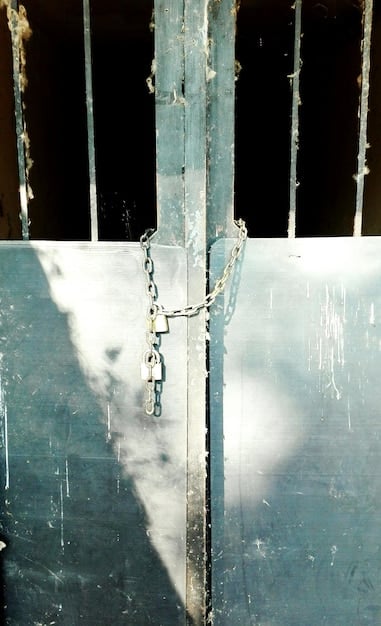How to Recognize and Report Hate Crimes: A Guide for Victims and Witnesses

This guide provides essential information for victims and witnesses on how to recognize a hate crime, understand the legal definitions, and effectively report such incidents to the appropriate authorities, ensuring justice and support.
Have you ever wondered what constitutes a hate crime and what steps you can take if you witness or experience one? Understanding how to recognize and report hate crimes: a guide for victims and witnesses is crucial for fostering safer communities and ensuring justice.
Understanding Hate Crimes
Hate crimes are more than just biased incidents; they are acts of violence and intimidation that target individuals or groups based on their identity. Recognizing the underlying motivations and the specific characteristics of these crimes is essential for effective prevention and response.
Defining Hate Crimes
A hate crime is typically defined as a criminal offense committed against a person or property that is motivated, in whole or in part, by an offender’s bias against a race, religion, disability, ethnic origin or sexual orientation.
Motivation and Bias
The key element that distinguishes a hate crime from other crimes is the offender’s motivation. Bias can be based on stereotypes, prejudices, or simply a dislike for a particular group.
- Race and Ethnicity: Crimes targeting individuals based on their race or ethnic background, often involving racial slurs or derogatory remarks.
- Religion: Crimes targeting religious institutions or individuals based on their religious beliefs.
- Sexual Orientation and Gender Identity: Crimes targeting individuals due to their sexual orientation or gender identity, including harassment and violence.
- Disability: Crimes targeting individuals with physical or mental disabilities, often involving exploitation or abuse.
Understanding the nuances of hate crimes begins with recognizing the specific biases that fuel them. These offenses are not merely random acts; they stem from deeply rooted prejudices that target core aspects of a person’s identity.

Recognizing a Hate Crime
Recognizing a hate crime requires more than just noting the occurrence of a crime; it involves understanding the context and intent behind the act. Victims and witnesses need to be aware of the signs that indicate a crime is motivated by bias.
Indicators of Bias Motivation
Several indicators can suggest that a crime is motivated by bias. These include the use of hate speech, symbols, or gestures directed at the victim’s group.
Hate Speech and Symbols
The presence of hate speech, either spoken or written, is a strong indicator of bias. This can include racial slurs, derogatory terms, or offensive symbols such as swastikas or burning crosses.
Contextual Clues
The context in which the crime occurs can also provide clues. For example, if a crime occurs near a religious institution or during a cultural event, it may suggest a bias motivation.
- Location: Crimes occurring in areas known for hate group activity.
- Timing: Crimes coinciding with significant dates for targeted groups.
- Past Incidents: A history of similar incidents in the area.
Recognizing a hate crime demands an understanding of the subtle yet telling signs of bias. By paying attention to these indicators, victims and witnesses can better identify and report these offenses.
Legal Definitions and Protections
Understanding the legal definitions and protections surrounding hate crimes is crucial for both victims and witnesses. Federal and state laws provide specific protections and penalties for these types of offenses.
Federal Laws
Several federal laws address hate crimes, including the Matthew Shepard and James Byrd Jr. Hate Crimes Prevention Act, which expands federal jurisdiction over hate crimes and includes protections based on sexual orientation and gender identity.
State Laws
Many states have their own hate crime laws that complement federal legislation. These laws vary by state but generally enhance penalties for crimes motivated by bias.
Reporting Laws
Some states also have laws requiring law enforcement agencies to report hate crimes to a central database, which helps track and monitor the prevalence of these crimes.
- Enhanced Penalties: Hate crimes often carry stiffer penalties than similar crimes without a bias motivation.
- Civil Rights Protections: Federal and state laws protect individuals from discrimination based on various characteristics.
- Victim Support: Many jurisdictions provide resources and support services for victims of hate crimes.
Legal definitions and protections form the backbone of justice for victims of hate crimes. Knowledge of these laws empowers individuals to seek recourse and hold perpetrators accountable.

How to Report a Hate Crime
Reporting a hate crime is a critical step toward seeking justice and preventing future incidents. Knowing who to contact and what information to provide can make the reporting process more effective.
Who to Contact
The first step in reporting a hate crime is to contact local law enforcement. In addition, victims and witnesses can also report the incident to federal agencies such as the FBI or the Department of Justice.
Documenting the Incident
It is important to document as much information as possible about the incident. This includes the date, time, and location of the crime, as well as a description of the offender and any hate speech or symbols used.
Community Organizations
Victims and witnesses can also seek support and guidance from community organizations that specialize in hate crime prevention and advocacy. These organizations can provide resources, counseling, and legal assistance.
- Local Police: Contact your local police department to report the crime.
- FBI: The FBI investigates hate crimes and can provide additional resources.
- Community Groups: Organizations like the Southern Poverty Law Center and the Anti-Defamation League offer support and advocacy.
Reporting a hate crime is a crucial step that not only seeks justice for the victim but also contributes to the overall effort to combat hate and discrimination. By understanding how to report these incidents, individuals can play a vital role in creating safer, more inclusive communities.
Supporting Victims of Hate Crimes
Providing support to victims of hate crimes is essential for their healing and recovery. This support can come from various sources, including family, friends, community organizations, and mental health professionals.
Emotional Support
Victims of hate crimes often experience emotional distress, including fear, anger, and anxiety. Providing a safe and supportive environment can help them process their emotions and begin to heal.
Practical Assistance
In addition to emotional support, victims may need practical assistance such as legal advice, medical care, or financial aid. Community organizations and government agencies can provide these resources.
Advocacy and Empowerment
Advocating for victims and empowering them to take action can help them regain a sense of control and justice. This can involve speaking out against hate, participating in community events, or pursuing legal remedies.
- Counseling: Professional counseling can help victims cope with trauma.
- Legal Aid: Legal assistance can help victims understand their rights and options.
- Community Support: Local organizations can provide resources and support groups.
Supporting victims of hate crimes requires empathy, understanding, and a commitment to providing the resources they need to heal and rebuild their lives.
Preventing Hate Crimes
Preventing hate crimes requires a multifaceted approach that includes education, community outreach, and policy changes. By addressing the root causes of hate and bias, we can create more inclusive and tolerant societies.
Education and Awareness
Educating people about the harmful effects of hate crimes and the importance of diversity and inclusion can help reduce bias and prejudice. Schools, workplaces, and community organizations can play a role in providing this education.
Community Outreach
Engaging with diverse communities and fostering dialogue can help break down barriers and build understanding. Community events, cultural celebrations, and interfaith dialogues can promote tolerance and respect.
Policy Changes
Advocating for policies that protect marginalized groups and hold perpetrators of hate crimes accountable can help prevent future incidents. This includes strengthening hate crime laws, increasing funding for victim support services, and promoting diversity and inclusion in all sectors of society.
- Inclusive Education: Promote curricula that celebrate diversity and challenge stereotypes.
- Community Programs: Support initiatives that foster understanding and dialogue.
- Strong Legislation: Advocate for laws that protect vulnerable groups.
Preventing hate crimes is a collective responsibility that requires ongoing efforts to educate, engage, and advocate for a more just and equitable society.
| Key Topic | Brief Description |
|---|---|
| 🚨 Recognizing Hate Crimes | Identifying bias indicators like hate speech and symbols. |
| ⚖️ Legal Definitions | Understanding federal and state laws protecting against hate crimes. |
| 📞 Reporting Procedures | Knowing who to contact, including local police and federal agencies. |
| 🤝 Supporting Victims | Providing emotional and practical aid to those affected. |
Frequently Asked Questions
▼
A hate crime is a criminal offense motivated by bias against a victim’s race, religion, sexual orientation, ethnicity, disability, or gender identity. It targets individuals because of their identity.
▼
Ensure your safety first. Contact local law enforcement to report the incident. Document everything, including details about the perpetrator, location, and any hate speech used.
▼
Yes, the Matthew Shepard and James Byrd Jr. Hate Crimes Prevention Act expands federal jurisdiction over hate crimes, including those based on sexual orientation and gender identity.
▼
Victims can access emotional support, legal assistance, medical care, and financial aid from community organizations, government agencies, and mental health professionals who understand the unique challenges they face.
▼
Engage in community outreach programs, support inclusive education, and advocate for policies that protect marginalized groups. Promote understanding and tolerance in your daily interactions and community events.
Conclusion
Understanding, recognizing, and reporting hate crimes are vital steps in creating safer and more inclusive communities. By staying informed and taking action, we can all contribute to a society where everyone is treated with dignity and respect.





